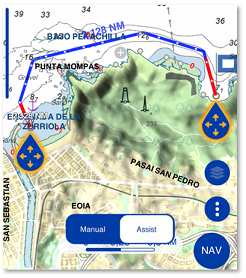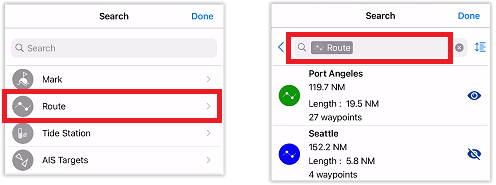Routes
TZ iBoat allows for the creation of up to 200 routes of 500 waypoints each allowing you to plan multiple voyages. TZ iBoat offers various ways of creating your route: using Route Assist, using a Manual mode, or by entering coordinates.
Creating a Route using Route Assist
With Route Assist, you can create a complex route with just two taps on the chart. Set the starting and ending waypoints, and Route Assist will automatically complete the route, ensuring it avoids obstructions and adheres to your safety depth, all at impressive speed.
If you want to go through a specific spot or if you are not satisfied with the proposed route, you can simply add, remove, or move waypoints, and see the route being updated in real time. Route Assist gives you the flexibility to adjust your route on the fly, making it a time saver for route planning.
But before using Route Assist for the first time, you need to adjust some parameters:
Configuring Route Assist:
Route Assist takes in account several parameters that you can find tune from the Routes Settings under the section “Route Assist”.
- Safety Depth: Route Assist will always avoid land, but it also ensures the route adheres to the minimum safety depth you have specified in the “Safety Depth” setting.
TIP: Feel free to increase the safety depth above your usual margin. This will cause the Route Assist algorithm to steer toward deeper waters. Some users might even decide to select the maximum safety depth value, which is 10m. With this large value, Route Assist will still be able to work even in shallow water (for example when entering/exiting marinas) by turning the legs red as a warning; but at the same time, it will continuously try to find the deepest possible routes, until 10m is reached.
- Strict Depth compliance: In some circumstances the Route Assist algorithm may create legs that are under the Route Assist Safety Depth setting. This might seem strange at first, but some harbors may be poorly charted or may not contain any depth information which would cause the Route Assist to never find a path to the destination if it was set to strictly comply with the safety depth setting. That is why, by default, the Route Assist may create legs in areas shallower than the safety depth setting. Note that this flexibility also allows Route Assist to create legs in shallow water to avoid a big detour. These legs will be clearly marked in red when that happens so that you can review them carefully. However, if you want Route Assist to strictly respect the safety depth, you can select “Strict Depth Compliance”; in this case, Route Assist will never create legs that go under the safety depth.
- Use Recommended Routes: If there is a recommended route or a recommended track on the chart, Route Assist will try to follow it. While "vector chart recommended routes" are provided by hydrographic offices and included in the charts, "crowd-sourced recommended routes" come from user-contributed data. These routes are not visible on the charts but are embedded in the underlying data, helping the Route Assist Algorithm in areas where the charts lack specific guidance.
- Boat Width and Boat Height: These two settings are not found under the Route Settings, but rather under the General Settings. Your boat width is used to avoid narrow passages, while boat height is used to avoid bridges that are lower than your boat air draft.
Creating a Route using the Route Assist mode:
To create a route, tap on the chart at the location you want the route to start and select “New Route” from the Pop-Up menu. The first waypoint will be created (represented with a starting flag). Make sure that the "Assist" mode is selected at the bottom of the screen:

Tap on the chart to create the next waypoint or tap directly on your destination. You don’t need to be accurate when creating the waypoints as you are able to move them to fine tune their location using their handles (just drag the "lollipops" displayed just below the waypoints). As soon as you have created 2 waypoints, the Assisted Route is displayed, starting from the first waypoint, and ending on the second one:

If you are satisfied with the result, simply tap on the route validation displayed at the top right of the screen:

However, if you want to make modifications to the route, you can:
- Continue tapping on the screen to extend the route by creating new waypoints along the way
- Tap on a leg to insert a waypoint (either tap and select "Insert Waypoint" or long tap on a leg to directly insert a waypoint)
- Tap on a waypoint handle and select "Delete Waypoint" to remove a waypoint
- Move a waypoint by dragging its handle
As soon as a modification is done, the Route Assist algorithm will recompute automatically any intermediate waypoints (any waypoint that were not created or modified by the user).
Remarks:
- Route Assist can work with both vector and raster charts (as long as the vector charts data has been downloaded).
- Routes created in Assist mode are synchronized with other TimeZero devices. However, if a device does not support the Route Assist feature, the route will be displayed and handled as a standard route.
- A Route has a maximum of 500 waypoints. When the Assisted Route is too complex, it can exceed this number. In that case you will get a “Too Many Points” error. If that happens, you will need to create a shorter route.
- The distance between two successive user waypoints is 500NM maximum. If you exceed this distance while creating the Assisted Route, you will get an error and the route will not be created; The best solution is to add an intermediate waypoint to reduce the distance between the waypoints.
Creating a Route using the manual mode
To create a route in manual mode, tap on the chart at the location you want the route to start and select “New Route” from the Pop-Up menu. The first waypoint will be created (represented with a starting flag). Make sure that the "Manual" mode is selected at the bottom of the screen:

Continue to tap on the chart to drop your waypoints and build your route. If you need to move a waypoint, simply use the handle displayed just under each waypoint. Note that you can pan and zoom the chart during the route building process.
To end a route, tap on the route validation displayed at the top right of the screen:

Creating a Route using coordinates
You can create a route by entering a succession of coordinates. This is useful when you want to create a route that is described in a Cruising Book by a succession of waypoints. Tap on the “TZ” button located on the top left of your screen, select “Add by Lat/Lon” from the Quick Actions and then select “Add Route by Lat/Lon”. This will display a dedicated Lat/Lon keyboard that will allow you to create waypoints using manual coordinates. Simply enter the coordinate of the first waypoint, then tap on “Add Point #1”. Repeat the process with all waypoints. When you are done, tap on “Done”.
Editing a Route
Both Manual and Assisted routes can be modified at any time. TZ iBoat tracks whether a route was created with the Manual or Assist mode. When you move a waypoint, the system maintains the route's characteristics. For routes created with Route Assist, the legs before and after the modified waypoint will be automatically recalculated using the Route Assist algorithm, keeping the “Assisted” characteristic of the route.
To edit a route first, tap on it to make sure it is selected. When a route is selected, you can perform various operation on the route by tapping on the route itself or on one of its waypoints and select the corresponding action from the Pop-Up menu:
-
To adjust a waypoint location, tap on it and select “Move” from the Pop-Up menu. Use the handle that appears just below the waypoint to drag it and then tap anywhere to validate the new position.
-
To remove (delete) a waypoint from the route, tap on it and select “Delete Waypoint” from the Pop-Up menu.
-
To insert a waypoint, tap on the route leg where you want to insert a waypoint and select “Insert” from the Pop-Up menu. This creates a new waypoint that you can drag using the handle. Tap anywhere to validate the new waypoint position.
-
To extend the route, tap on it and select “Extend” from the Pop-Up menu. This will restart the route building process from the last waypoint.
-
To reverse a route, tap on it and select “Reverse” from the Pop-Up menu.
-
To rename a route, tap on it and select “Rename” from the Pop-Up menu on iPhone, or tap on the name itself from the Pop-Up menu on iPad.
Note: By default, the route name is not displayed on the chart, but this can be adjusted by enabling “Route Label” from the Routes settings.
Hiding and Displaying Routes
After creating a route, the header will transform into the “Selected Route” header that allows you to either activate the route for navigation (left button) or hide the route (right button):

Note that when building or after selecting a route, the header will display a Time To Arrival (TTA). This time is based on the route length and the “Planning Route Speed” set in the Routes settings.
To help reduce clutter on your screen, TZ iBoat only displays one route at a time (the “selected route”). All other routes will be collapsed into a departure (default) or an arrival icon located respectively at the first or last waypoint of the route. To expand a route, simply tap on its collapsed icon:

TIP: If you have lots of routes starting from the same departure point, it might make more sense to set the “Route Icon Position” to “Arrival” instead from the Routes settings. This way the collapsed route icon will be located on the last waypoint making it easier to select the route.
Once a route is expanded (or “selected”), the route header will be displayed at the top of your screen. If you want to collapse this route, either select another route or click on the “Hide” button located on the right side of the route header.
Route List
If you want to display a list of all your routes or search for a specific route by its name, you can use the Search feature of TZ iBoat. Tap on the “TZ” button located on the top left of your screen, select “Smart Search”, and select "Route":

You can search by name and filter the content of the list if you start typing a text. You can also sort the list by name (alphabetical order), range (distance from boat), route length, date (creation date) or color.
When you select a route from a list, the route is automatically expanded (made visible) on the chart and will stay selected when you close the search window. You can then tap on the activate button from the selected route header to start navigating.